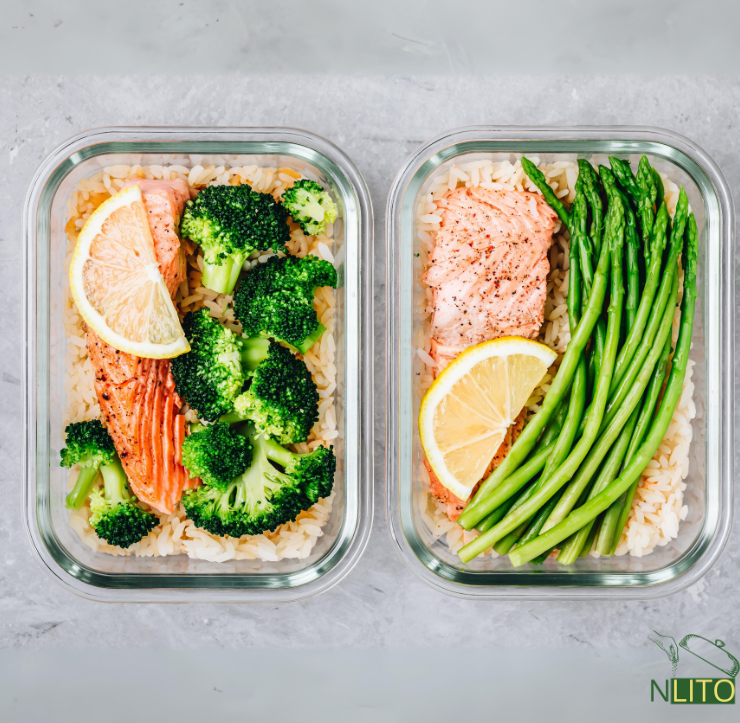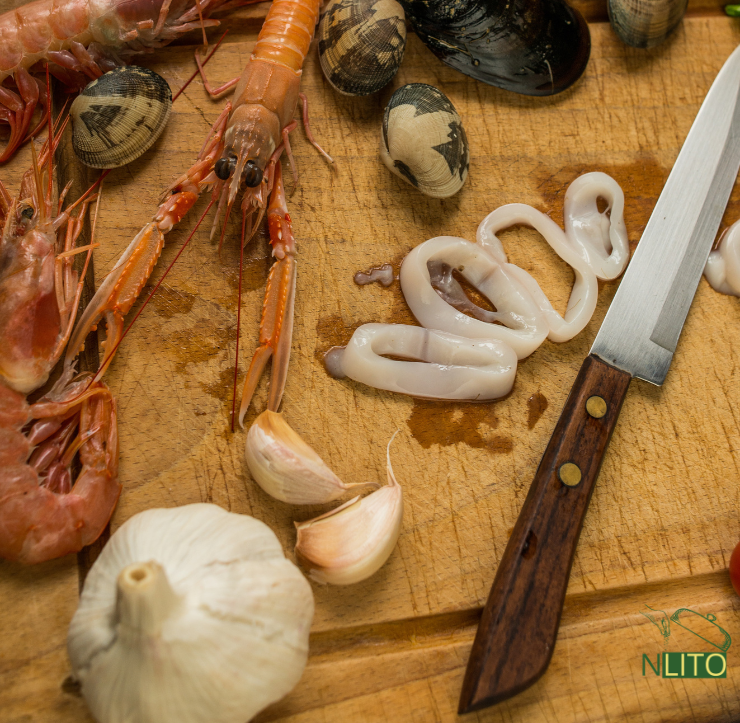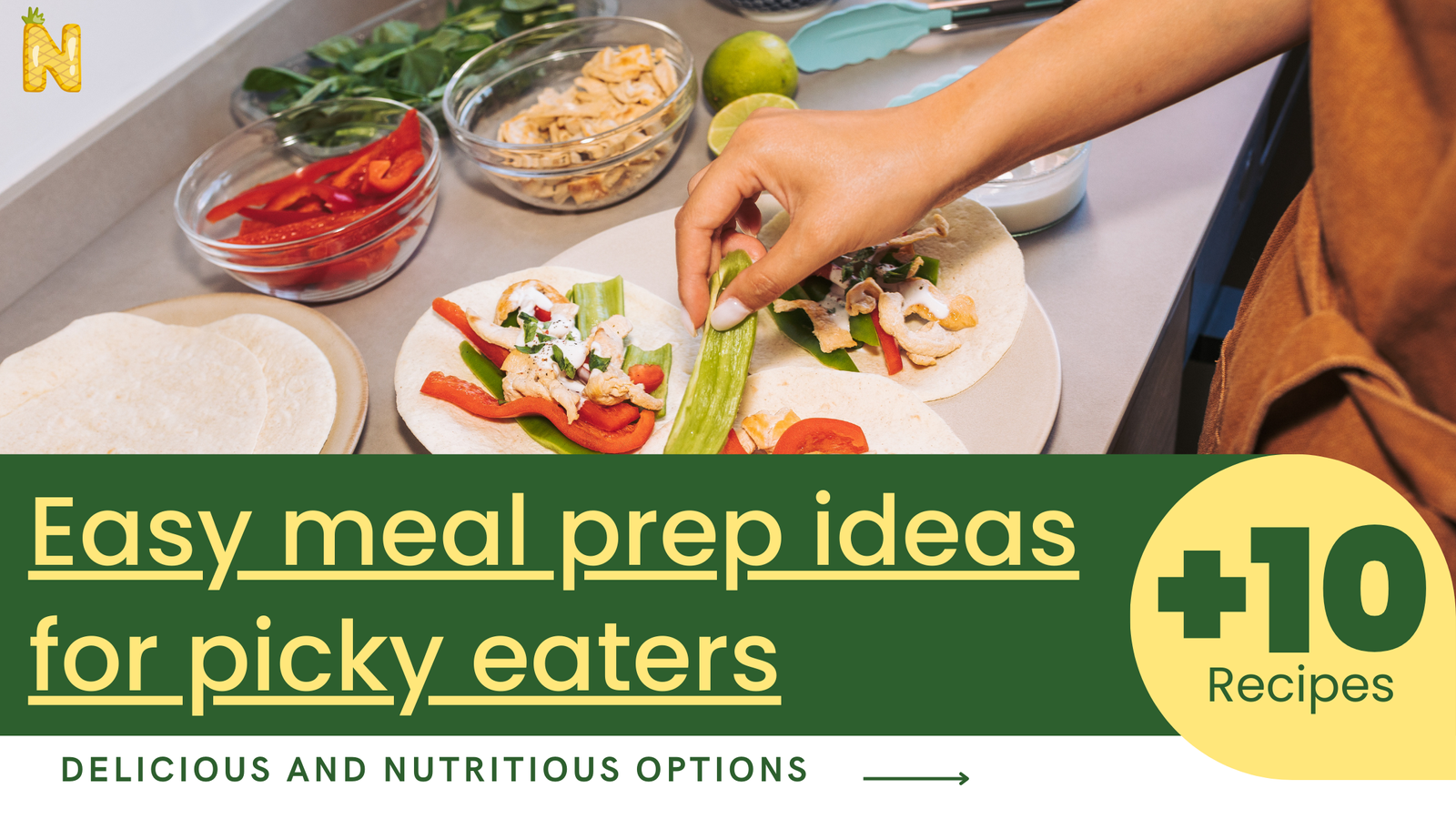Introduction to Pescatarian Meal Prep
The pescatarian diet is a flexible and nutritious way of eating that includes fish and seafood while excluding other meats like beef, pork, and poultry. Many people choose this diet for its health benefits, environmental considerations, or simply for the love of seafood. However, like any diet, maintaining balance and variety is key to ensuring you get all the nutrients your body needs.
Meal prepping is a powerful tool for anyone looking to follow a pescatarian diet. By planning and preparing meals in advance, you can save time, reduce food waste, and ensure that your meals are both delicious and nutritious. Whether you’re new to meal prep or looking to refine your process, this guide will provide you with essential tips and ideas to make pescatarian meal prep easy and enjoyable.
Essential Ingredients for Pescatarian Meal Prep
Overview of Seafood Options: Fish, Shellfish, and More
Seafood is the cornerstone of the pescatarian diet, offering a rich source of protein, omega-3 fatty acids, and essential vitamins and minerals. Popular options include fatty fish like salmon and mackerel, which are high in omega-3s, as well as leaner choices like cod and tilapia. Shellfish, such as shrimp, scallops, and mussels, add variety and can be cooked quickly, making them ideal for meal prep.
Plant-Based Proteins: Beans, Lentils, and Tofu
In addition to seafood, incorporating plant-based proteins can add variety and balance to your meals. Beans and lentils are excellent sources of fiber, protein, and iron, and they pair well with seafood dishes. Tofu, made from soybeans, is another versatile protein that can be marinated and added to stir-fries, salads, or bowls.
Whole Grains: Quinoa, Brown Rice, and Couscous
Whole grains provide essential carbohydrates that fuel your body and keep you feeling full. Quinoa is a complete protein, meaning it contains all nine essential amino acids, making it a great addition to pescatarian meals. Brown rice and couscous are also excellent choices that can be cooked in bulk and used as the base for various dishes throughout the week.
Tools and Equipment for Effective Meal Prep
Essential Kitchen Tools for Meal Prep
Having the right tools on hand can make meal prep faster and more efficient. Key items include sharp knives, cutting boards, measuring cups, and a quality set of pots and pans. A food processor or blender can be useful for preparing sauces, dressings, and smoothies, while a steamer basket allows you to cook vegetables and seafood quickly and healthily.
Best Containers for Storage and Portion Control
Investing in high-quality containers is essential for keeping your prepped meals fresh and organized. Look for BPA-free plastic or glass containers with airtight lids to prevent leaks and spills. Divided containers are also helpful for portion control, especially if you’re preparing multiple components for a meal, such as fish, grains, and vegetables.
Tips for Organizing Your Kitchen Space for Meal Prep
Organization is key to successful meal prep. Keep your pantry stocked with essential ingredients, and arrange your kitchen tools in a way that makes them easily accessible. Designate a specific area of your kitchen for meal prep activities, and consider using labels to keep track of what’s in your fridge and freezer. This way, you’ll save time and reduce stress when it’s time to cook.
How to Plan Your Pescatarian Meal Prep
Setting Nutritional Goals
Before you start meal prepping, it’s essential to set clear nutritional goals. This involves understanding your daily protein, carbohydrate, and fat needs, as well as ensuring you’re getting enough vitamins and minerals. For pescatarians, this might mean focusing on omega-3 fatty acids from fish, adequate protein from both seafood and plant-based sources, and a variety of vegetables to provide essential nutrients. By setting these goals, you can create meals that not only taste great but also support your overall health and wellness.
Creating a Balanced Weekly Meal Plan
A balanced weekly meal plan should include a variety of foods to ensure you’re getting a wide range of nutrients. Start by planning out your main meals—breakfast, lunch, and dinner—for each day of the week. Include a mix of seafood, plant-based proteins, whole grains, and plenty of vegetables. Consider how leftovers can be repurposed for another meal, which can save time and reduce waste. For example, grilled salmon from dinner can be used in a salad for lunch the next day.
Budgeting for Pescatarian Meals
While seafood can be more expensive than other protein sources, there are ways to keep your pescatarian diet budget-friendly. Buying in bulk, especially when it comes to grains, beans, and frozen seafood, can save money. Additionally, plan your meals around seasonal produce, which tends to be cheaper and fresher. Shopping at local markets or directly from fishmongers can also help you get the best prices on high-quality seafood. Finally, consider incorporating more plant-based meals into your plan to balance the cost.
Quick and Easy Breakfast Ideas
Overnight Oats with Chia Seeds and Berries
Overnight oats are a quick and nutritious breakfast option that you can prepare the night before. Simply combine rolled oats with your choice of milk, a tablespoon of chia seeds, and a handful of berries in a jar. Let it sit in the fridge overnight, and in the morning, you’ll have a delicious and filling breakfast ready to go. You can also add toppings like nuts, seeds, or a drizzle of honey for extra flavor and nutrients.
Smoked Salmon and Avocado Toast
Smoked salmon and avocado toast is a classic pescatarian breakfast that’s both satisfying and nutrient-dense. Start with a slice of whole-grain bread, top it with mashed avocado, and add a few slices of smoked salmon. You can also sprinkle some lemon juice, capers, or red pepper flakes on top for added flavor. This meal provides healthy fats, protein, and fiber, making it a great way to start your day.
Greek Yogurt Parfaits with Nuts and Honey
Greek yogurt parfaits are another easy breakfast option that you can prepare ahead of time. Layer Greek yogurt with your favorite fruits, such as berries or sliced bananas, and add a handful of nuts for crunch. Drizzle with honey for sweetness. These parfaits are rich in protein, probiotics, and healthy fats, and they can be easily customized to suit your taste preferences.
Protein-Packed Lunches
Quinoa and Grilled Shrimp Salad
This quinoa and grilled shrimp salad is a light yet filling lunch option that’s packed with protein. Start by cooking quinoa according to the package instructions, then mix it with grilled shrimp, chopped vegetables like cucumbers, cherry tomatoes, and red onion, and a simple lemon vinaigrette. This salad can be made in advance and stored in the fridge, making it a convenient option for busy weekdays.
Tuna and White Bean Salad with Lemon Dressing
Tuna and white bean salad is a protein-rich meal that requires no cooking, making it perfect for quick lunches. Combine canned tuna with white beans, chopped red onion, parsley, and a lemon dressing made with olive oil, lemon juice, and Dijon mustard. Serve it over a bed of greens or with whole-grain bread for a complete meal. This salad is not only tasty but also provides a good mix of protein, fiber, and healthy fats.
Chickpea and Avocado Wraps with a Side of Fresh Fruit
For a plant-based lunch option, try chickpea and avocado wraps. Mash chickpeas with avocado, lime juice, cumin, and salt, then spread the mixture onto a whole-grain wrap. Add toppings like shredded lettuce, sliced tomatoes, and red cabbage for crunch. Roll it up and serve with a side of fresh fruit. These wraps are easy to prepare, transport, and eat on the go, making them a great option for meal prep.
Flavorful Dinner Options
Baked Salmon with Roasted Vegetables
Baked salmon is a staple in many pescatarian diets because it’s easy to prepare, delicious, and packed with omega-3 fatty acids. For this meal, season salmon fillets with olive oil, garlic, lemon juice, and your favorite herbs, then bake them in the oven until they’re cooked through. Serve with a side of roasted vegetables like Brussels sprouts, carrots, and sweet potatoes for a balanced and flavorful dinner. This dish can be prepped in advance and reheated when ready to eat.
Shrimp Stir-Fry with Brown Rice and Broccoli
Shrimp stir-fry is a quick and versatile dinner option that can be made with a variety of vegetables. Start by sautéing shrimp in a hot pan with a bit of olive oil and garlic until they’re pink and cooked through. Remove the shrimp and add chopped broccoli, bell peppers, and snap peas to the same pan. Once the vegetables are tender, return the shrimp to the pan, and toss everything together with soy sauce and a dash of sesame oil. Serve over brown rice for a complete meal that’s ready in under 30 minutes.
Fish Tacos with Slaw and Avocado Dressing
Fish tacos are a fun and delicious way to enjoy seafood for dinner. Use a firm white fish like cod or tilapia, season with cumin, chili powder, and lime juice, and cook in a pan until flaky. Serve the fish in warm corn tortillas topped with a crunchy slaw made from shredded cabbage, carrots, and a tangy lime dressing. Add a dollop of creamy avocado dressing for extra flavor. These tacos are easy to assemble and can be customized with your favorite toppings like salsa, cilantro, or jalapeños.
Snack Ideas to Keep You Full
Cucumber and Hummus Bites
For a light and refreshing snack, cucumber and hummus bites are a perfect choice. Slice cucumbers into rounds and top each slice with a spoonful of hummus. You can add a sprinkle of paprika or chopped parsley for extra flavor. These bites are low in calories but high in fiber and healthy fats, making them a great option for satisfying midday hunger.
Mixed Nuts and Dried Fruit
A handful of mixed nuts and dried fruit is a convenient and portable snack that provides a good balance of protein, healthy fats, and natural sugars. Choose a variety of nuts like almonds, walnuts, and cashews, and pair them with dried fruits like apricots, cranberries, or raisins. This snack is easy to portion out in advance and can be kept on hand for when you need a quick energy boost.
Edamame with Sea Salt
Edamame, or young soybeans, are a high-protein snack that’s both simple and satisfying. You can buy them fresh or frozen, and they’re typically boiled or steamed until tender. Sprinkle with sea salt and enjoy them as is, or toss them with a little chili powder or sesame oil for added flavor. Edamame is an excellent source of plant-based protein, fiber, and essential nutrients like iron and calcium.
Batch Cooking for Pescatarians
Benefits of Batch Cooking for Meal Prep
Batch cooking is a time-saving strategy that involves preparing large quantities of food at once, which can then be portioned out and stored for later use. For pescatarians, batch cooking is particularly useful because it allows you to make the most of fresh seafood while it’s at its peak quality. By cooking in bulk, you can ensure that you always have healthy, homemade meals on hand, reducing the temptation to order takeout or eat out.
How to Batch Cook Seafood Without Losing Freshness
Seafood can be delicate, so it’s important to know how to batch cook it properly to maintain its flavor and texture. One method is to cook seafood dishes like soups, stews, or casseroles that hold up well in the fridge or freezer. For example, you can make a large pot of seafood chowder or a tray of baked fish fillets that can be stored and reheated as needed. Be sure to cool seafood dishes quickly after cooking and store them in airtight containers to prevent spoilage.
Freezing and Reheating Tips for Batch-Cooked Meals
When freezing batch-cooked meals, it’s important to portion them out before freezing to make reheating easier. Use freezer-safe containers or bags, and label each with the date and contents. To avoid freezer burn, remove as much air as possible from the containers before sealing. When reheating seafood meals, do so gently to prevent overcooking. For best results, thaw frozen meals in the refrigerator overnight before reheating them in the oven, on the stovetop, or in the microwave.
Incorporating International Flavors
Mediterranean-Inspired Meals: Grilled Fish with Tzatziki and Tabbouleh
The Mediterranean diet is known for its heart-healthy ingredients, making it a perfect match for pescatarians. For a Mediterranean-inspired meal, try grilled fish served with tzatziki sauce and tabbouleh. Use a firm white fish like sea bass or snapper, marinate it in olive oil, lemon juice, garlic, and oregano, then grill until cooked through. Pair the fish with a refreshing tzatziki sauce made from Greek yogurt, cucumber, and dill, and serve alongside a light and flavorful tabbouleh salad made with bulgur wheat, parsley, tomatoes, and lemon juice.
Asian-Inspired Meals: Sushi Bowls with Tuna and Seaweed Salad
Sushi bowls are a fun and deconstructed way to enjoy the flavors of sushi without the need for rolling. Start with a base of sushi rice, and top it with fresh tuna, avocado, cucumber, and sliced radishes. Add a side of seaweed salad for extra texture and flavor. Drizzle with soy sauce, a sprinkle of sesame seeds, and a dollop of wasabi or pickled ginger for an authentic sushi experience. This meal is light, fresh, and packed with protein and healthy fats, making it a great option for lunch or dinner.
Latin-Inspired Meals: Ceviche with Corn and Sweet Potato
Ceviche is a traditional Latin American dish made with raw fish that’s “cooked” in citrus juice. For a pescatarian-friendly ceviche, use firm white fish like tilapia or sea bass, and marinate it in lime juice until it becomes opaque. Mix the fish with diced red onion, tomatoes, cilantro, and jalapeños for a burst of flavor. Serve the ceviche with sides of sweet corn and roasted sweet potatoes to balance the acidity of the dish. Ceviche is a refreshing and light meal that’s perfect for warmer weather.
Healthy Desserts for Pescatarians
Greek Yogurt with Honey and Pistachios
Greek yogurt with honey and pistachios is a simple yet satisfying dessert that’s both healthy and delicious. The creamy yogurt is rich in protein and probiotics, while the honey adds natural sweetness and the pistachios provide a crunchy texture and healthy fats. This dessert can be made in minutes and is a great way to end a meal on a light note without sacrificing flavor.
Berry Chia Seed Pudding
Chia seed pudding is a versatile and nutritious dessert that can be prepared in advance. To make it, mix chia seeds with your choice of milk (such as almond or coconut milk), and let it sit in the fridge until the seeds absorb the liquid and the mixture thickens. Add fresh berries and a drizzle of honey or maple syrup for sweetness. This pudding is packed with fiber, omega-3 fatty acids, and antioxidants, making it a guilt-free treat that’s also great for breakfast or a snack.
Dark Chocolate and Nut Clusters
For a quick and indulgent dessert, dark chocolate and nut clusters are a perfect choice. Melt dark chocolate, then mix it with a variety of nuts like almonds, walnuts, and hazelnuts. Spoon the mixture onto a parchment-lined baking sheet, and let it cool until the chocolate hardens. These clusters are rich in antioxidants and healthy fats, making them a delicious way to satisfy your sweet tooth while still sticking to a healthy diet.
Tips for Staying on Track with Meal Prep
How to Stay Motivated with Meal Prep
Staying motivated with meal prep can be challenging, especially when life gets busy. One way to stay on track is to set aside a specific day each week for meal prep and treat it as an essential part of your routine. Make the process enjoyable by listening to music or a podcast while you cook, and reward yourself with a treat or a favorite activity once you’re done. Remember the benefits of meal prep—saving time, eating healthier, and reducing stress—and let those motivate you to keep going.
Adjusting Meal Prep for Social Events and Holidays
Social events and holidays can disrupt your meal prep routine, but with a little planning, you can stay on track. If you know you’ll be attending a social event, plan your meals around it by preparing lighter meals earlier in the week or adjusting your portions. For holidays, consider preparing pescatarian-friendly dishes that you can bring to gatherings, so you have options that fit your diet. Flexibility is key—don’t be afraid to adjust your plan as needed while still maintaining a healthy balance.
Adapting Recipes Based on Seasonal Produce
One of the best ways to keep your meal prep fresh and exciting is by adapting recipes based on seasonal produce. Seasonal fruits and vegetables are often more flavorful, nutritious, and affordable. In the summer, focus on incorporating fresh berries, tomatoes, and zucchini into your meals, while in the winter, root vegetables, citrus fruits, and leafy greens take center stage. By rotating seasonal ingredients, you can enjoy a variety of flavors and nutrients throughout the year.
Common Mistakes to Avoid in Pescatarian Meal Prep
Overcooking Seafood
One of the most common mistakes when preparing pescatarian meals is overcooking seafood. Unlike meat, seafood cooks quickly, and even a few extra minutes can result in a tough, dry texture. To avoid this, keep a close eye on cooking times and use methods like steaming, poaching, or baking at lower temperatures. Investing in a good meat thermometer can also help you achieve perfectly cooked fish every time by ensuring it reaches the correct internal temperature without overcooking.
Not Diversifying Protein Sources
Another mistake is relying too heavily on one type of protein, such as fish, and neglecting other sources like shellfish, tofu, and plant-based proteins. A diverse diet is important for ensuring you get a wide range of nutrients. By varying your protein sources, you can also keep your meals interesting and avoid getting bored with your diet. Incorporate beans, lentils, and other legumes into your meal plan, and explore different types of seafood to create a balanced and varied pescatarian diet.
Forgetting to Include Enough Fiber and Healthy Fats
Fiber and healthy fats are crucial components of a balanced diet, yet they are sometimes overlooked in meal prep. Seafood is an excellent source of protein and healthy fats, but it’s important to complement it with high-fiber foods like vegetables, whole grains, and legumes. Additionally, don’t shy away from healthy fats found in olive oil, avocado, nuts, and seeds. These fats not only add flavor but also help with nutrient absorption and keeping you full longer.
Frequently Asked Questions About Pescatarian Meal Prep
How Long Can You Store Prepped Seafood Meals?
Prepped seafood meals can generally be stored in the refrigerator for up to 3 days. For longer storage, freezing is the best option. Cooked fish and seafood dishes can be frozen for up to 3 months without significant loss of quality. When storing, make sure to use airtight containers to prevent the food from drying out and absorbing other flavors from the fridge or freezer. Always label your containers with the date to keep track of freshness.
What Are Some Sustainable Seafood Choices for Meal Prep?
Sustainability is an important consideration when choosing seafood for your meal prep. Opt for fish and shellfish that are responsibly sourced and have minimal impact on the environment. Some sustainable choices include Alaskan salmon, Pacific sardines, farmed mussels, and Arctic char. Check for certifications like the Marine Stewardship Council (MSC) label, which indicates that the seafood was caught using sustainable practices. Supporting sustainable seafood helps protect ocean ecosystems and ensures that you can enjoy seafood for years to come.
Can You Meal Prep with Frozen Fish and Seafood?
Yes, frozen fish and seafood are great options for meal prep. In fact, frozen seafood is often frozen at peak freshness, preserving its quality and nutrients. When meal prepping with frozen seafood, thaw it safely in the refrigerator overnight before cooking. Once thawed, it can be used in the same way as fresh seafood. Keep in mind that some seafood, like shrimp, can be cooked directly from frozen, saving you even more time during meal prep.
Conclusion
Meal prepping as a pescatarian offers a range of benefits, from saving time and reducing food waste to ensuring you enjoy a balanced and nutritious diet. By incorporating a variety of seafood, plant-based proteins, whole grains, and seasonal vegetables, you can create delicious and diverse meals that support your health and well-being. With the right tools, planning strategies, and a focus on sustainability, meal prepping can become an enjoyable and rewarding part of your routine. Start today, and discover how easy and satisfying pescatarian meal prep can be!







Leave a Comment